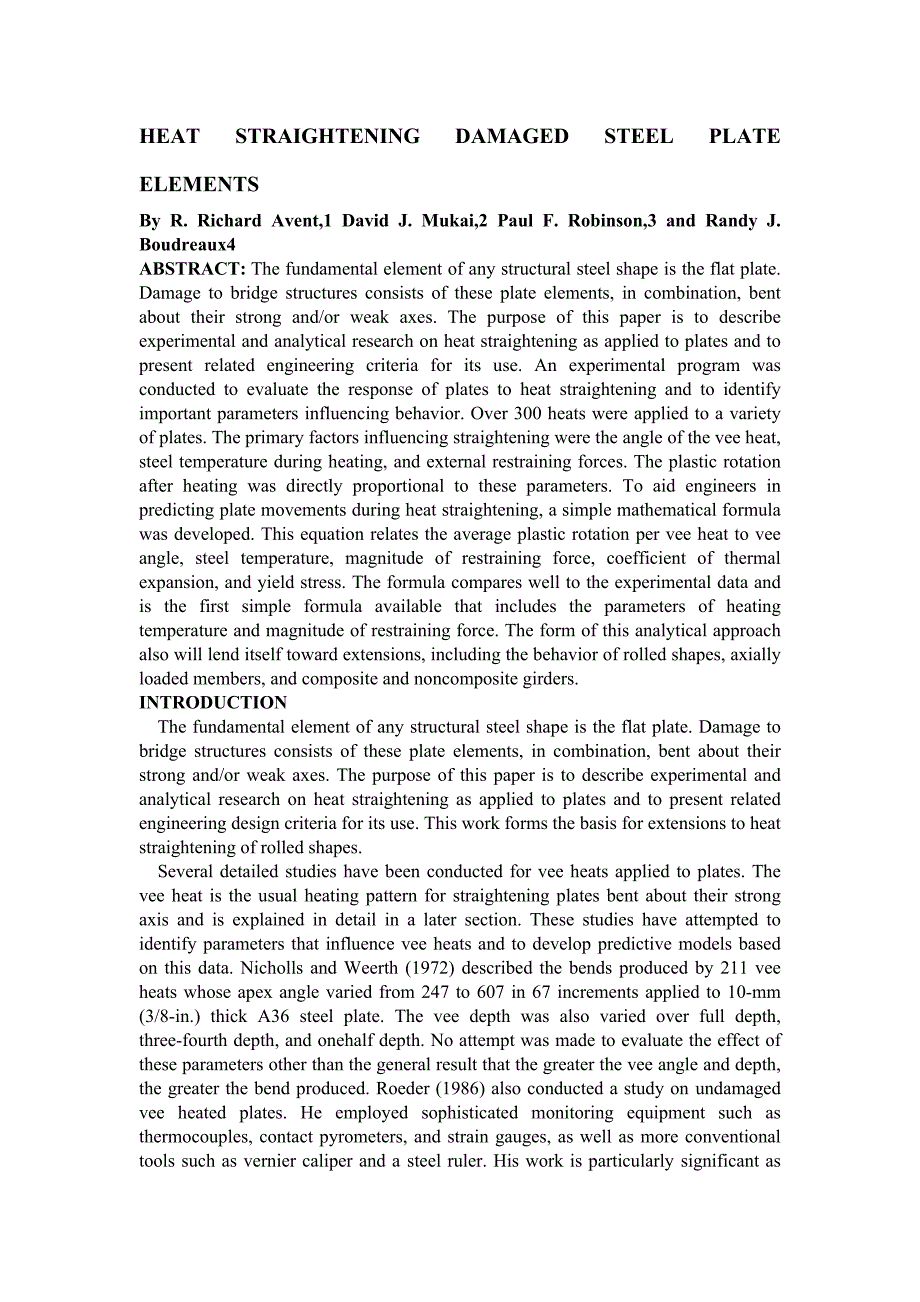资源预览内容
space
第1页 / 共18页
space
第2页 / 共18页
space
第3页 / 共18页
space
第4页 / 共18页
space
第5页 / 共18页
space
第6页 / 共18页
space
第7页 / 共18页
space
第8页 / 共18页
space
第9页 / 共18页
space
第10页 / 共18页
亲,该文档总共18页,到这儿已超出免费预览范围,如果喜欢就下载吧!
资源描述
HEAT STRAIGHTENING DAMAGED STEEL PLATE ELEMENTSBy R. Richard Avent,1 David J. Mukai,2 Paul F. Robinson,3 and Randy J. Boudreaux4ABSTRACT: The fundamental element of any structural steel shape is the flat plate. Damage to bridge structures consists of these plate elements, in combination, bent about their strong and/or weak axes. The purpose of this paper is to describe experimental and analytical research on heat straightening as applied to plates and to present related engineering criteria for its use. An experimental program was conducted to evaluate the response of plates to heat straightening and to identify important parameters influencing behavior. Over 300 heats were applied to a variety of plates. The primary factors influencing straightening were the angle of the vee heat, steel temperature during heating, and external restraining forces. The plastic rotation after heating was directly proportional to these parameters. To aid engineers in predicting plate movements during heat straightening, a simple mathematical formula was developed. This equation relates the average plastic rotation per vee heat to vee angle, steel temperature, magnitude of restraining force, coefficient of thermal expansion, and yield stress. The formula compares well to the experimental data and is the first simple formula available that includes the parameters of heating temperature and magnitude of restraining force. The form of this analytical approach also will lend itself toward extensions, including the behavior of rolled shapes, axially loaded members, and composite and noncomposite girders.INTRODUCTIONThe fundamental element of any structural steel shape is the flat plate. Damage to bridge structures consists of these plate elements, in combination, bent about their strong and/or weak axes. The purpose of this paper is to describe experimental and analytical research on heat straightening as applied to plates and to present related engineering design criteria for its use. This work forms the basis for extensions to heat straightening of rolled shapes. Several detailed studies have been conducted for vee heats applied to plates. The vee heat is the usual heating pattern for straightening plates bent about their strong axis and is explained in detail in a later section. These studies have attempted to identify parameters that influence vee heats and to develop predictive models based on this data. Nicholls and Weerth (1972) described the bends produced by 211 vee heats whose apex angle varied from 247 to 607 in 67 increments applied to 10-mm (3/8-in.) thick A36 steel plate. The vee depth was also varied over full depth, three-fourth depth, and onehalf depth. No attempt was made to evaluate the effect of these parameters other than the general result that the greater the vee angle and depth, the greater the bend produced. Roeder (1986) also conducted a study on undamaged vee heated plates. He employed sophisticated monitoring equipment such as thermocouples, contact pyrometers, and strain gauges, as well as more conventional tools such as vernier caliper and a steel ruler. His work is particularly significant as the first attempt to both experimentally and analytically quantify heatstraightening behavior for plates over a wide range of parameters. The parameters included vee geometry, specimen geometry, heating temperature and rate, steel grade, restraining force, initial residual stresses, and quenching. Roeders conclusions were based on approximately 60 heats over a wide range of parameters. As a result there were relatively few re-petitive heats using identical parameters. Although trends could be drawn from this data, its sparseness limited the quantitative value of the results. However, his research provided the initial basis for much of the experimental work reported here. Roeders most significant conclusions were A practical and safe upper heating treatment limit is 6507C (1,2007F). Changes in material properties are small when the heating temperature remains below the phase transition temperature of approximately 7207C (1,3307F). The rotation produced by a vee heat is directly proportional to vee angle and heating temperature. The rotation produced by a vee heat is directly proportional to restraining forces that produce compression in the open end of the vee during heating. Quenching is effective and may increase vee heat rotations, but heating temperatures should be kept below the phase transition temperature although some practitioners recommend quenching only if the steel temperature is below 7007F or (3707C). Plastic strain occurs primarily within the vee heat region. Plastic strain is somewhat sensitive to geometry of the plate. However, much of this sensitivity can be attributed to differences in rate of heating and heat flow. The research described in this paper extends Roeders work and includes enough repetitive data points to quantify these and other conclusions.Lite
网站客服QQ:2055934822
金锄头文库版权所有
经营许可证:蜀ICP备13022795号 | 川公网安备 51140202000112号
